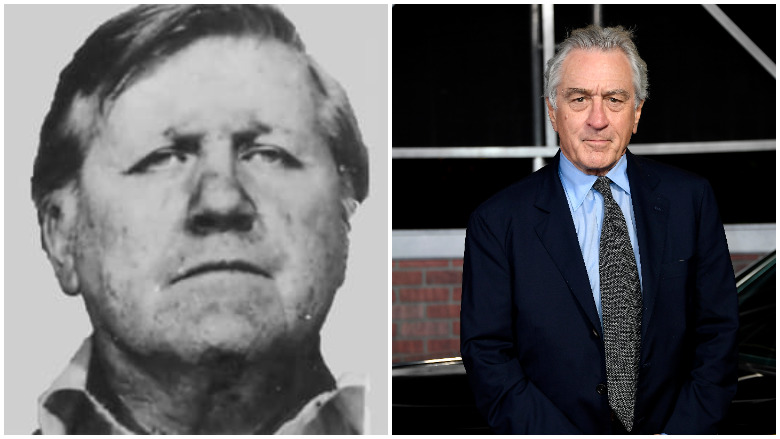
Mugshot/Getty What is the real story behind Robert DeNiro's portrayal of Frank Sheeran?
Frank Sheeran is the mobbed-up protagonist in The Irishman, Martin Scorsese’s much-awaited Mafia epic on Netflix. In the movie, Robert De Niro plays the labor union “goon,” who claims to know the answers to one of the greatest unsolved mysteries: Who killed Jimmy Hoffa? (Be forewarned that there are spoilers in this article for The Irishman inasmuch as it aligns with real life.)
The Irishman is based on the 2004 biography of Sheeran’s life called I Heard You Paint Houses by writer Charles Brandt, who argues that Sheeran confessed to murdering Teamster boss Hoffa. This has never been proven; Hoffa’s body has never been found. According to The Smithsonian, many historians dispute Sheeran’s claims that he killed Hoffa, who vanished in July 1975 in Detroit and was never seen again. In fact, as far back as 1975, another gangster named Salvatore Briguglio was being named as a suspect along with four other mobsters, none of whom as Sheeran.
When they first met, Sheeran says in the book that Jimmy Hoffa told him “I heard you paint houses.” He said yes and added: “I do my own carpentry work too.” That means you shoot people in mob hits and then get rid of the bodies yourself.
What’s the real story of Frank Sheeran? Is the movie true? First of all, Sheeran is a real person. And, although some doubt his claims of killing Hoffa, he did make a list of suspects in a memo compiled by the lead FBI investigator at the time. He clearly had mob ties, including to people some experts believe ordered the hit or carried it out. It’s also true that he confessed. Whether you believe the confession is another story.
The Brandt book describes Sheeran as a “witty Irishman…raised a devout Catholic…a tough child of the Great Depression; a combat-hardened hero of World War II…”

Pictured: Frank Sheeran and his first wife, Mary, along with their three daughters: Peggy, Dolores, and MaryAnne.
Here’s what you need to know:
Frank Sheeran Was a Truck Driver, a World War II Veteran, and a Mob & Jimmy Hoffa Associate
News articles from the 1970s and 1980s make one thing clear: Sheeran was acquainted with both Hoffa and Pennsylvania Mafia boss Russell Bufalino, who introduced Sheeran to the labor leader. Those ties were long-lived and ran pretty deep. Sheeran was, indeed, known as “The Irishman” or “Big Irish Frank Sheeran.”
He had a family of three daughters. His former wife, Mary R. (nee Leddy) Sheeran died in April 2005 in Pennsylvania, leaving behind children MaryAnne Cahill, Peggy Sheeran, and Dolores S. Miller, her obituary says. Peggy stopped talking to him after the Hoffa disappearance.
Whether Sheeran murdered Hoffa is a theory that emerged in the Brandt book in 2004, although it’s not the first time that Sheeran’s name came up in connection with the disappearance.
The book jacket explains that “I heard you paint houses” were “the first words Jimmy Hoffa ever spoke to Frank ‘the Irishman’ Sheeran. To paint a house is to kill a man. The paint is the blood that splatters on the walls and floors.”
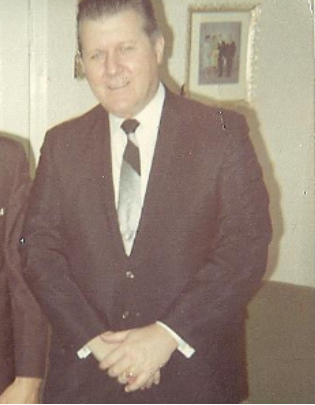
Frank Sheeran in real life.
The book continues: “In the course of nearly five years of recorded interviews Frank Sheeran confessed to Charles Brandt that he handled more than twenty-five hits for the mob, and for his friend Hoffa. Sheeran learned to kill in the U.S. Army, where he saw an astonishing 411 days of active combat duty in Italy during World War II. After returning home he became a hustler and hit man, working for legendary crime boss Russell Bufalino.”
The book claims that the real-life Sheeran killed Hoffa: “Eventually he would rise to a position of such prominence that in a RICO suit then-U.S. Attorney Rudy Giuliani would name him as one of only two non-Italians on a list of 26 top mob figures. When Bufalino (played by Joe Pesci on Netflix) ordered Sheeran to kill Hoffa, he did the deed, knowing that if he had refused he would have been killed himself.”
According to The Smithsonian, the real Sheeran was an Irish-Catholic WWII veteran and truck driver. He did “small jobs” for Bufalino. He claimed in the book that he was the “right-hand” man of Jimmy Hoffa (played on Netflix by Al Pacino). He was the son of Thomas Francis Sheeran, an Irish-American painter in Philadelphia, and Mary Hanson, who was of Swedish descent. Here’s his application for World War II veterans’ benefits. He used his given name, Francis J. Sheeran, on that application.
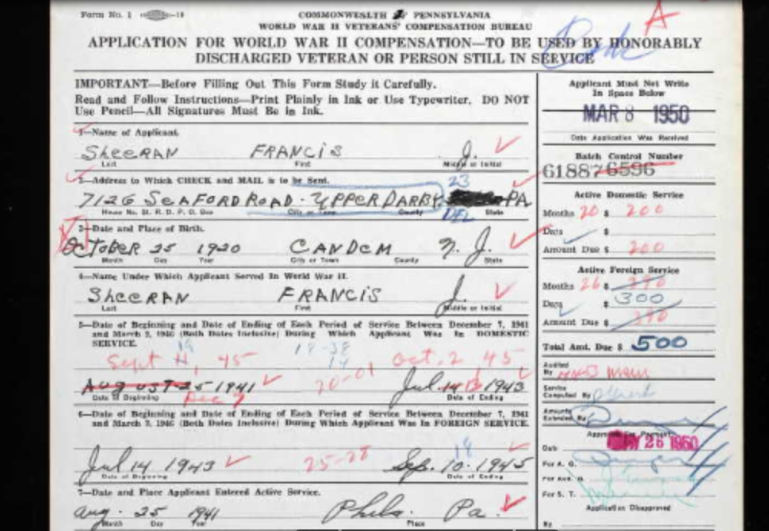
Frank Sheeran WWII veterans’ compensation application.
Here’s his dad’s draft registration card. In the Brandt book, Sheeran said he got his size from his mother’s Swedish side. Her father was a miner and railroad worker in Sweden. He wrote that his Irish-American father “raised us Irish.” His “people were from outside Dublin,” and he didn’t meet any of his grandparents. His father was a steel worker and school janitor. Thomas studied to be a priest. He was an amateur boxer.
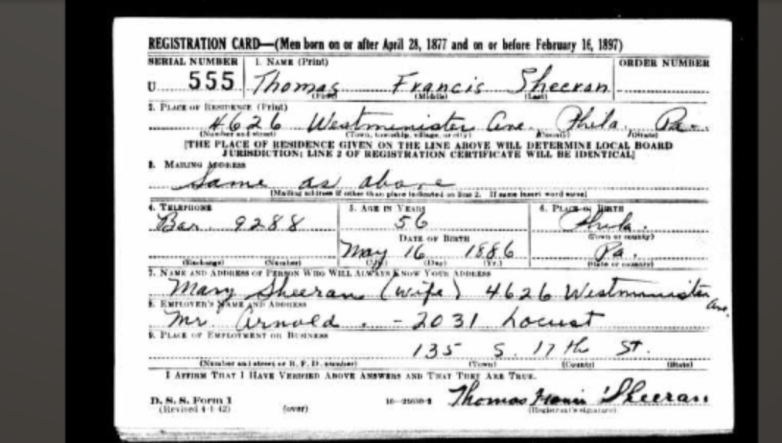
Frank Sheeran’s dad’s World War II draft card.
Here’s his father’s World War I benefits application.
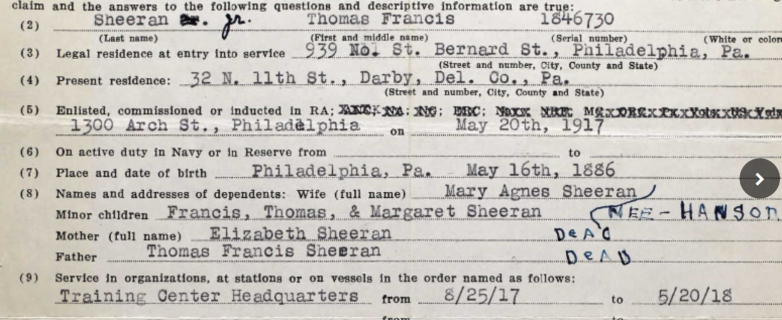
Ancestry recordsA WWI compensation form for Frank’s dad.
1940 census records show the family.

1940 census records for Frank Sheeran’s birth family.
In August 2019, Bill Tonelli wrote an article in Slate Magazine called “The Lies of the Irishman.” The article calls the real Sheeran “a second-stringer—a local Teamsters union official.”
He “hung around with mobsters,” stood 6 foot 4 inches tall, and “died in obscurity, in a nursing home, in 2003,” Tonelli wrote. Sheeran told Brandt that he killed both Hoffa and mobster and Colombo family member Joe Gallo. Tonelli doesn’t buy it in either case. He’s not alone.
However, Sheeran’s account is plausible. People who think someone else pulled the trigger tend to attribute the Hoffa slaying (he was declared dead legally, although his body was never found) to a small group of Detroit and Pennsylvania mobsters. Sheeran was deeply affiliated with them all, especially the mobster, Russell Bufalino, who most people think ordered the hit.
In the book, Sheeran said that bosses and captains “sent a guy to whack you who was your friend” because they could get “close to you in a lonely spot.” Also any evidence left could be more easily explained. He was Hoffa’s friend and says that Hoffa mistakenly thought that Sheeran was there for his protection. He thought he was meeting members of the Detroit and Pennsylvania mob in a Detroit house, but ended up with a bullet in the head instead. Sheeran says he delivered it.
The lead FBI agent investigating the Hoffa case was Robert Garrity, and a 1976 memo he authored gave Garrity’s preliminary conclusions, including possible suspects, in the Hoffa disappearance. Sheeran is on that list.
It starts: “James R. Hoffa, age 62, former president International Brotherhood of Teamsters, missing from Bloomfield Township, since July 30, 1975. Last seen at approximately 2:45 p.m. that date.”
The memo lists 6 local suspects and 6 suspects outside Michigan. Sheeran makes the second list. The memo says: “Francis Joseph ‘Frank’ Sheeran, age 43, president Local 326, Wilmington, Delaware. Resides in Philadelphia and is known associate of Russel (sic) Bufalino, La Cosa Nostra chief, Eastern Pennsylvania. His vehicle seen at meeting of La Cosa Nostra figures in Wilkes Barre, Pennsylvania, August 29, 1975, and also in Detroit December 4, 1975, during FGJ appearance of New Jersey teamsters. Known to be in Detroit area at the time time of JRH disappearance and considered to be close friend of JRH.”
Read the memo in full here.
Other key names in it to remember:
Anthony “Tony Pro” Provenzano, then age 58, “known New Jersey La Cosa Nostra member and Teamster Local 560 Officer. Served time in Lewisburg Penitentiary with JRH and reportedly had a ‘falling out’ with him while there.”
Anthony “Tony Jack” Giacalone, described as age 57, Detroit La Cosa Nostra lieutenant and street boss “who was reported to have set up meeting with JRH, July 30, 1975, and never showed. Has alibi being at Southfield Athletic Club, July 30, 1975. Married to a Provenzano, who may be a relative of Anthony Provenzano.”
Salvatore “Sal” Briguglio, age 45, “trusted associate of ‘Tony Pro,’ reported by Newark source to be involved in actual disappearance of JRH.”
Charles L. “Chuckie” O’Brien, age 41, was raised by the Hoffa family and brought into the Teamsters by JRH and supported by him. Called Tony Giacalone “Uncle Tony” but was a known liar.
There Are Many Old News Articles Describing Sheeran as a ‘Hoffa Man,’ a Teamster & Mafia Associate
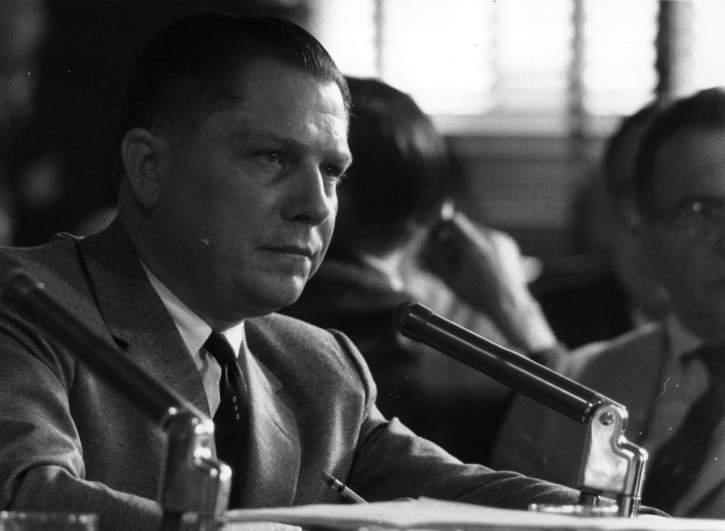
American labour leader Jimmy Hoffa (1913 – 1975).
Sheeran was clearly – undeniably – embedded in the Teamsters and Mafia life.
A November 5, 1970 article in the Philadelphia Daily News reported that “the labor people of this town” were preparing to honor Frank Sheeran, described as “The Teamster.”
Three years before, he was “very big in the Teamsters.” He was running for the presidency of Teamsters Local 326 in Wilmington.
He repeatedly found himself the target of authorities. The article said that, in 1967, Sheeran was standing on the sidewalk outside a union hall when a Teamster named Bobby DeGeorge was shot and killed. Sheeran didn’t shoot him but was charged with murder as a conspirator, and some union members felt it was unfair. He was running for acting president of 326 at the time.
The article says that Sheeran stood 6 foot 3 inches tall and weighed 248 pounds. He lost the presidency election because of the murder accusation and “went back to driving a truck between Wilmington and Pittsburgh.”
The article quoted Sheeran as saying, “Sure, I’m a Hoffa man. I’ll never deny that. Never.”
A Tom Fox column on September 20, 1974 in the Philadelphia Daily News, described Sheeran as “the big Teamster who looks like he could handle a wild bull one on one.” That article reports that the murder charge was dismissed under the 6th Amendment guarantee to a speedy trial after being postponed “an unbelievable 42 times.”
The article describes Frank Joseph Sheeran as the “son of a Depression steeplejack who worked as a church sexton at Our Mother of Sorrows at 48th and Lancaster in West Philadelphia” and at BVM. The New York Post reports that Sheeran was raised in Darby Pennsylvania in a “rough-and tumble childhood.” He joined the military in 1941 and was sent to Italy. He moved to Philadelphia in 1945, got married, and began working as a grocery chain truck driver, The Post reported. By 1955, he was running errands for gangster Russell Bufalino.
“I never shot anybody,” Sheeran said in that article, which ran before Hoffa was slain. He said a testimonial was being held that would see Jimmy Hoffa at the head table with his wife and four daughters. He said: “They were the only people who believed in me seven years ago – my wife, and my girls and my friend, Jimmy Hoffa.”
Sheeran Was the Subject of Federal Racketeering Trials in Real Life
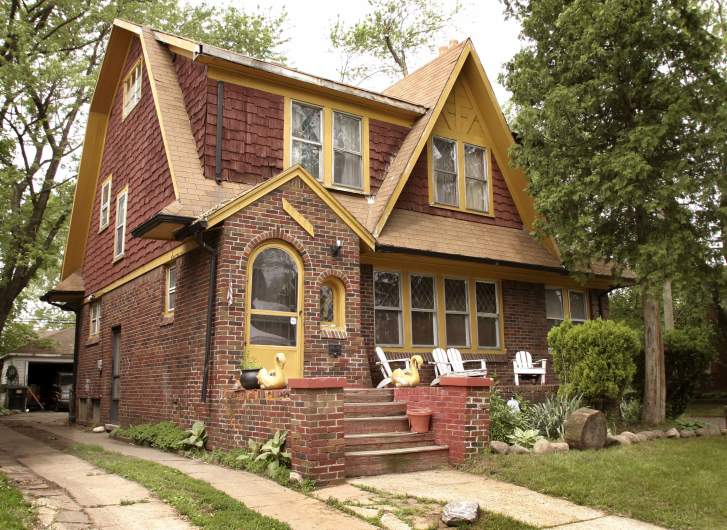
The house being investigated in the case of Teamsters President Jimmy Hoffa’s July 30, 1975 disappearance is seen May 29, 2004 in northwest Detroit, Michigan.
The government eventually got their man, Frank Sheeran. But it took awhile, and he died a free man.
An Associated Press story from February 22, 1980 explained how prosecutors had demanded a conviction for Sheeran in a federal racketeering trial. The defense claimed Sheeran was indicted “because he drove around Russell Bufalino whom the United States claims is a gangster.”
The main witness was an informant and former hitman, Charles Allen. At that time, Sheeran was described as 59, “grey-haired,” living in Philadelphia and president of Teamsters Local 326 in Wilmington, Delaware. The article says Sheeran testified that he knew Bufalino, described by authorities as “an organized crime chieftain in northeastern Pennsylvania, for over 25 years.” By this point, Bufalino was in federal prison. The charges against Sheeran included the slaying of a Wilmington Teamster named Frederick J. Gawronski.
According to a 1980 article in the Wilmington News Journal, Allen taped 50 conversations with Sheeran in the late 1970s, claiming Sheeran “paid him for two murders, three attempted murders, and two arsons.”
The government alleged that Sheeran “works for Russell Bufalino,” the story reported. Sheeran, the article said, indicated the government had offered him “all kinds of deals” to provide information on what happened to Hoffa. A 1979 article in the same newspaper described Sheeran as having “always an implied threat in his personality, the way he carries himself, the language he uses.”
There were two racketeering cases, though. In the first one, he was acquitted by a jury that didn’t believe the informant. In the second, he was convicted in a labor-racketeering case in Wilmington.
A 1981 article described Sheeran as “the gray-haired paunchy old man who emerged from federal court with a labor racketeering conviction.” He had money troubles and health issues by then, including a back problem that “caused him to carry a cane to court and wear a corset at home.”
The article said that Sheeran’s biggest worry was that the government thought he might know who killed Hoffa. It says that “Sheeran was in Detroit the same weekend Hoffa took a final trip.”
Eight years before he had said, “I’ll be a Hoffa man till they pat my face with a shovel and steal my cufflinks.”
A 1981 News Journal article said that he was once called a “union goon.” In 1996, The Daily Item newspaper in Pennsylvania ran an Associated Press article that described Sheeran as “Big Irish Sheeran, a former Teamster boss and Hoffa bagman.”
It said that Sheeran was planning to break his silence and solve the Hoffa case.
In that story, Sheeran claimed President Richard Nixon and Former Attorney General John Mitchell ordered Hoffa’s “assassination,” telling reporters, “This was purely a Republican, Old-Guard Nixon-Mitchell conspiracy to kill Jimmy Hoffa.”
By 1982, the Morning News in Wilmington, Delaware, was calling “Big Frank Sheeran” the “former Teamster leader and independent businessman.”
The article stated that Sheeran would stop for wine at a mob hangout called Cous’ Little Italy. He was appealing convictions for “labor racketeering and plotting to blow up a plan and beat up an employer,” it says. By this point, his wife was described as his ex-wife.
The appeal didn’t work, and he went to prison.
At age 74, he was released from prison after serving 13 years in the second racketeering conviction.
He was described as a “dear personal friend” of Hoffa but also “for years a prime suspect in his boss’ disappearance.”
It’s True Sheeran Confessed to Killing Hoffa But Other Suspects Were Named for Years
In 2005, the Detroit Free Press ran a column by Brandt who indicated that the “truth is that the Jimmy Hoffa mystery is solved by the confession of Frank (The Irishman) Sheeran as detailed in my book.”
He wrote: “Sheeran was a close confidant of Hoffa and was forced to kill his friend and mentor by his godfather, Russell Bufalino.”
Sheeran told Brandt, “If I had said no to Russell, Jimmy would have been just as dead and I’d have gone to Australia with him.”
The article said that Sheeran was “raised a devout Catholic” and suffered from guilt. Brandt wrote that, after their “last taping session,” Sheeran stopped eating “and was dead in six weeks at 83.”
Hoffa vanished after “meeting two reputed mob figures” at a Detroit-area restaurant. A 2004 Associated Press article reported that Hoffa disappeared “from the parking lot of a Detroit restaurant while on his way to a meeting with Anthony Provenzano, a New Jersey Teamsters boss, and Anthony Giacalone, a Detroit mobster.”
In 2004, the Morning Call in Allentown, Pennsylvania reported that investigators looking into Hoffa’s disappearance had discovered traces of blood inside a home where Sheeran claimed he shot Hoffa. A prosecutor said the chemical tests were inconclusive, and the FBI was looking for Hoffa DNA.
The article reported that there were two confessions, including a purported deathbed confession in which Sheeran “said he flew to Pontiac on a small plane,” picked up Hoffa’s body from the actual killers and “drove it to a Hamtramck trash incinerator, where it was burned.”
Sheeran’s daughter claimed that confession was a forgery due to warring biographers, the article reported.
The article reported that “investigators believe Provenzano and Giacalone had Hoffa killed to prevent him from regaining the union presidency” and says he was declared dead in 1982. Some theories even have Hoffa entombed under Giants stadium.
A 2005 article by the Associated Press reported that blood on the floor of the home ended up not being from Hoffa.
Sheeran’s daughter Dolores Miller, told Cosa Nostra News: “I suspected my father was behind Jimmy’s death but I never asked him directly. My mother disagreed. She said he and Jimmy were as thick as thieves but my gut instinct told me otherwise.”
The site reported that Sheeran’s parents “were devoutly religious Irish-Americans” and that he lied about his age to go to war at 17, fighting under Patton. His wife was named Mary and she was an Irish immigrant. He had daughters Mary Anne, Peggy and Dolores.
Vince Wade, the reporter who broke the story of Hoffa’s disappearance, wrote in a 2019 article in the Daily Beast that he doesn’t believe the Sheeran story about killing Hoffa is true.
According to Wade, Hoffa was urged by mob figures to “attend a peace meeting with Provenzano to clear the air” and told his wife that’s who he was meeting the afternoon he vanished. The “broker” of that meeting, according to Wade, was Giacalone, a mob enforcer from Detroit. Both men had alibis. It was documented that Hoffa’s foster son Chuckie O’Brien was driving his car.
Wade reported that police think Hoffa was driven by O’Brien to the murder site but didn’t kill him. Hoffa’s hair and scent were found in the car.
In 1975, mob informant Ralph Picardo said that “trusted associates of Provenzano” killed Hoffa. According to Wade, Bufalino was the most likely high-level mobster to have ordered the hit. He reports that Salvatore Briguglio, a trusted Provenzano man, was believed to be the Hoffa killer. Garrity, the Hoffa case agent for the FBI, told Wade that Sheeran was interviewed, and Hoffa had called him the day before he disappeared but that Garrity has “no indication he (Sheeran) was there.”
As for Briguglio? He was murdered in 1978 as he was about to go on trial for a homicide.
That’s not the story that Sheeran gives, though, although it involves some of the same characters.
In 2004, an article in the Detroit Free Press discussed Sheeran’s confession. It stated that the FBI has “long suspected that (Tony) Provenzano henchmen – brothers Thomas and Stephen Andretta and brothers Gabriel and Salvatore Briguglio – killed Hoffa to prevent him from regaining the Teamster presidency.” They were worried he would cut off “mob access to union pension funds,” according to the Free Press.
Sheeran claimed that Bufalino ordered him to kill Hoffa because national Mafia figures were sick of Hoffa threatening to cut the mob off from the union and thought he might be an FBI snitch. Sheeran claimed that Hoffa thought he would protect him and was driven by foster son Chucky O’Brien. He implied the Andretta brothers and Sal Briguglio were at the death house, the Free Press reported.
Whichever mobster pulled the trigger (and people debate this), many people believe that Russell Bufalino was the mobster who ultimately ordered it. Anthony Provenzano, nicknamed “Tony Pro,” was an east coast Mafioso and New Jersey union leader who was tied to the Genovese Crime Family. Tony Pro had bad blood with Hoffa since they were in prison together and Hoffa refused to alter union rules so Tony could keep his pension. In Sheeran’s story, Hoffa still thought he was meeting Tony Pro and a Detroit mobster Tony Giacalone, but they weren’t there. He thought Giacalone was going to mediate a truce between Hoffa and Tony Pro.
Sheeran claimed that, brought to a house in Detroit, Hoffa realized it was a hit, but it was too late because he was lured into believing that Sheeran was there as his protection (they were long-time friends). He said he shot him “in the back of the head behind his right ear. My friend didn’t suffer,” according to the Detroit newspaper. Sheeran said that Bufalino claimed Hoffa’s body was burned in either a trash incinerator or funeral home, according to The Detroit Free Press article.
Way back in December 1975, an article in the Orlando Sentinel reported that a then-mysterious informant had named three New Jersey teamsters with alleged Mafia ties in Hoffa’s disappearance. Salvatore “Sally Bugs” Briguglio, 47, then of Paramus, New Jersey, and his brother, Gabriel, of East Rutherford, and Thomas Andretta, 38, of Hasbrouck Heights, were ordered to appear before a police lineup after being named by the informant.
Police and federal sources said that Hoffa’s disappearance was “approved by the highest echelons of organized crime.” Both Sally Bugs and Andretta had ties to the Genovese crime family in New York, according to the article. William Bufalino, the lawyer tied to Russell Bufalino claimed in the story that none of the brothers had been in Detroit before the appearance.
It described Briguglio as “business agent of Local 560 in Union City, New Jersey,” once headed by Anthony “Tony Pro” Provenzano. Provenzano is the mobster who had a falling out in prison and later with Hoffa, as chronicled in Sheeran’s book, news articles from the time, and The Netflix movie. News articles from the time indicate that it was widely believed that Tony Pro ordered the hit, with orders from more powerful crime bosses, but wasn’t at the scene himself.
In 1978, the Associated Press quoted unnamed law enforcement officials as saying that Briguglio personally arranged the “contract murder,” of Hoffa and they hoped that his murder would result in a break in the case. That article, though, claimed the killers were a relative and close friend of Briguglio. Sally Bugs was later gunned down by two men, the article states. Although The Irishman makes it appear that Sheeran committed this murder, there’s no evidence of that.
Two eyewitnesses said they saw Frank’s foster son Chuckie O’Brien and Briguglio in the car with Hoffa, that article states.
A 1987 article in the Lansing State Journal reported that authorities still were “no closer to indicting those responsible” than they were when the abduction first occurred. A federal grand jury reviewed evidence without issuing an indictment.
Witnesses did put Hoffa at the restaurant in Detroit that day and his car was later found in the parking lot of the restaurant.
A special agent in charge of the FBI’s Detroit office indicated to the Associated Press in 1977 that there were five primary suspects.
The Lansing State Journal article named the suspects as Provenzano, Salvatore Briguglio (by then dead), his brother Gabriel, Thomas Andretta, and Anthony Giacalone. Sheeran is not mentioned.
In his book on the Teamsters, journalist Steven Brill said that the two Briguglio brothers and Andretta carried out the murder at the order of Provenzano. Hoffa was then put into a “giant shredder-compacter- incinerator,” claimed Bill. But the FBI said they discounted the theory of what was done with the body but not the theory of who did it, according to Lansing State Journal.
The car of Chuckie O’Brien, Hoffa’s foster son, was tested and the FBI found that a blood stain on its front seat was fish blood but they couldn’t verify if human blood was brought in. Trained dogs “detected Hoffa’s scent in the car and in the car’s trunk. A hair follicle covered with blood believed to be Hoffa’s was reportedly found in the car,” Lansing State Journal says.
READ NEXT: The Real Story of Tony Pro.
